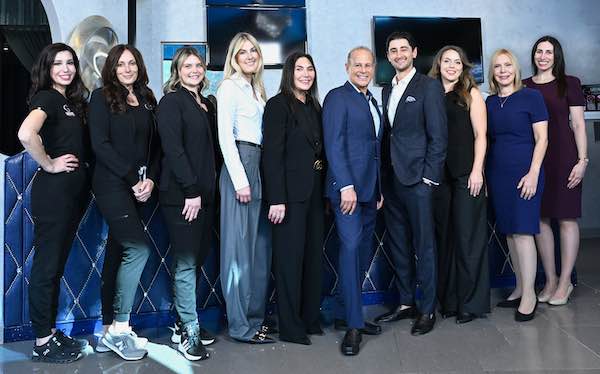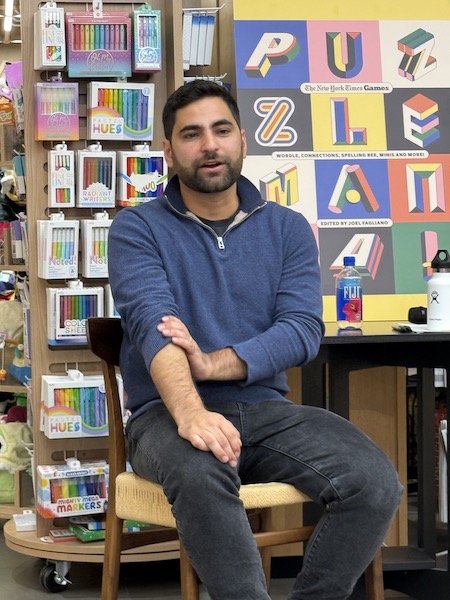Thank You For Reading --- And For Supporting Local News in Scarsdale
- Details
- Written by: Joanne Wallenstein
- Hits: 540
 It’s been another eventful year in Scarsdale — in the Village, in our schools, on our playing fields, and in the thoughts and actions of the many interesting people who call this town home.
It’s been another eventful year in Scarsdale — in the Village, in our schools, on our playing fields, and in the thoughts and actions of the many interesting people who call this town home.
What were some of the stories that captured our community this year? A ban on phones in the Scarsdale Schools. A young woman detained by ICE. A community debate about surveillance. A long-awaited resolution to build Scarsdale’s first indoor pool. Protesters at a League of Women Voters luncheon. And the year-long wait for a market to finally open in town.
There is never a dull moment here — and we are proud to bring the news of the neighborhood to you each week.
Believe it or not, we’ve been publishing continuously since 2009 — and we’ve never missed a week. Over the years, we’ve built a dedicated team of paid reporters and photographers who cover the schools, Village government, police and fire, sports, food, events, the real estate market, and everything else that matters to our readers. Though some assume we are underwritten by Scarsdale Village, we receive no outside support.
So, beyond reading the site each week, how can you support this community news portal?
First, we want to hear from you. Please send your news tips, letters, and opinions to [email protected].
to hear from you. Please send your news tips, letters, and opinions to [email protected].
Second, we ask you to consider making an annual donation to help underwrite the work of this site. Think of it as purchasing a subscription. While the newsletter magically arrives in your inbox every Thursday, it takes many hours of reporting, writing, editing, and curation to make it happen. Your contribution helps ensure that we can continue bringing you thoughtful, timely, and independent local news.
Donating is simple and secure — and your support helps guarantee that Scarsdale continues to have a vibrant community news source dedicated to the town we all love. Please support us so we can continue shining a light on the people, stories, and issues that make Scarsdale unique.
Happy New Year, and thank you for your continued support.
Holiday Gifts from the ‘Dale
- Details
- Written by: Joanne Wallenstein
- Hits: 1190
 How fortunate we are to live in Scarsdale surrounded by beauty, friends, wonderful schools, and our Village in a Park. What better way to express your gratitude than to do your holiday shopping in town and support the local business owners who support our community. This year there’s an amazing selection of great gifts, jewelry, accessories, flowers, books, scent, spa services, food and even cars to please everyone on your list.
How fortunate we are to live in Scarsdale surrounded by beauty, friends, wonderful schools, and our Village in a Park. What better way to express your gratitude than to do your holiday shopping in town and support the local business owners who support our community. This year there’s an amazing selection of great gifts, jewelry, accessories, flowers, books, scent, spa services, food and even cars to please everyone on your list.
Here's what available near home for the 2025 holiday season:
Fashion and Jewels
This season, give a gift with style and meaning. I Am More Scarsdale brings you a curated collection of our favorite cozy-chic layers, winter accessories, handbags and pouches, everyday jewelry, games, and MORE — with gifts starting at just $25.
our favorite cozy-chic layers, winter accessories, handbags and pouches, everyday jewelry, games, and MORE — with gifts starting at just $25.
As a women-owned boutique rooted in purpose, every purchase supports our mission to empower women and give back to the causes that matter most — many right here in our community. I Am More Scarsdale operates as a philanthropic business, with ownership foregoing a salary to donate profits to the organizations it supports
Shop where style meets strength — and make every gift count. I Am More Scarsdale, 6 Spencer Place, Scarsdale, 914-723-6673 (MORE) @iammore.scarsdale For 35 years, Pamela Robbins has defined timeless luxury, styling our community with a thoughtful curated edit. This holiday season, we celebrate you—our loyal clients and neighbors—whose trust and style have shaped our story.
For 35 years, Pamela Robbins has defined timeless luxury, styling our community with a thoughtful curated edit. This holiday season, we celebrate you—our loyal clients and neighbors—whose trust and style have shaped our story.
Discover new arrivals from The Row, Victoria Beckham, Marni, Nili Lotan, and Proenza Schouler alongside collections from newcomers Kallmeyer, Lisa Yang, Highsport, Heirlome, and Extreme Cashmere.
Season Highlights:
• RABANNE- Iconic bags including the new Nano Discs, 1969 classic, Moon bag and Chainmail Earrings featured. 
Follow @PAMELAROBBINSNY for event details and explore styles from the brands you’ve come to love — Proenza Schouler, Stella McCartney, and Toteme.
Come visit us at: 5 Boniface Circle, Scarsdale or call 914.472.4033 or visit our site: pamelarobbins.com
Eye Gallery of Scarsdale is filled with the newest styles from Chanel, Chrome Hearts, Loewe, Jacques Marie Mage, Barton Perreira, Oliver Peoples and many more. Shop for someone special or find a frame you will want to wear the moment you try it on. You can also  take a moment to book your annual eye exam with Dr. Michael Rosen and his expert team.
take a moment to book your annual eye exam with Dr. Michael Rosen and his expert team.
Stop by their beautiful new location on Boniface Circle and browse a curated mix of premium, designer frames with personalized service. Holiday perks are available in-store all season and you can walk in anytime to shop with no appointment needed.
Find the perfect gift. Visit today and bring home something unforgettable.
Eye Gallery of Scarsdale, 15 Boniface Circle, Scarsdale, (914) 472-2020.
Holsten Jewelers invites you this holiday season to experience over 100 years of family tradition and craftsmanship. We specialize in engagement rings,  custom designs, jewelry repair, watch restoration and more.
custom designs, jewelry repair, watch restoration and more.
Helena Rose: For the person who loves jewelry that feels personal and stands out, Helena Rose delivers pieces that are bold, meaningful, and truly unique. These rings are perfect for anyone that loves fun, statement pieces!
EF Collection: EF Collection is ideal for anyone who wants classic, everyday diamonds that go with absolutely everything. The designs are clean, timeless, and effortless — pieces you can put on once and never take off. It’s the go-to choice for someone who appreciates understated luxury.
Adina Reyter: For the person who loves something sentimental, Adina Reyter’s charm necklaces are all about meaning and personal storytelling. Each charm can represent a memory, a milestone, or something uniquely “them.” It’s the perfect way to build a necklace that grows with time.
Holsten Jewelers, 5 Harwood Court, Scarsdale, (914) 472-4554, Tue - Sat 10 AM - 5 PM
Rocks Jewelry Gift Home: For a unique shopping experience, visit ROCKS Jewelry • Gifts • Home • Design in the Golden Horseshoe. We are a full-service Fine and Fashion jewelry store, including repairs and custom work. You’ll also find more than fifty Home Accessory brands — from Made Goods, Arteriors, Globals Views, and Jonathan Adler. Need help accessorizing? We offer full service Interior Design services, including furniture,  art, wallpaper, and lighting. Yes, we do it all! ROCKS is the best place to shop for Hostess Gifts, with a huge selection of gift items starting as low as $25. Enjoy our ROCKS Concierge services. Call, email, or go online... and get it delivered right to your door.
art, wallpaper, and lighting. Yes, we do it all! ROCKS is the best place to shop for Hostess Gifts, with a huge selection of gift items starting as low as $25. Enjoy our ROCKS Concierge services. Call, email, or go online... and get it delivered right to your door.
A Hostess Favorite.: Medium Acacia Cheese Board, $75; Resin Coated Cheese Knife Set, $40
These cheese boards blend Acacia hardwood and an eco-friendly resin to create a one-of-a-kind piece of serveware for your home. In addition, these beautiful 4-piece cheese knife sets are made with stainless steel, solid wood handle and gorgeous eco-friendly resin. Each knife is unique. They make the perfect gift.
Make her holiday shine with these elegant Roar Lion Hoop earrings in 14K gold, $3,000. Sophisticated and eye-catching, elevate your look and make a statement.
Golden Horseshoe Shopping Center, Wilmot Road Scarsdale , 914-219-5808
Flowers
Scarsdale Flower Boutique: This year, dress up your home and table with holiday bouquets, centerpieces, Christmas wreaths and custom-made topiary trees from the Scarsdale Flower Boutique.
 Choose from orchids, star of Bethlehem, stock, ranunculus and colorful flowers for yourself or as gifts for friends. Bring a poinsettia, an orchid or an amaryllis to your holiday gathering.
Choose from orchids, star of Bethlehem, stock, ranunculus and colorful flowers for yourself or as gifts for friends. Bring a poinsettia, an orchid or an amaryllis to your holiday gathering.
Click here to see holiday arrangements, starting at $50 for pick up in store, or $75 for same day delivery. Order soon for Christmas. Call 914-723-0852, order online here or stop by the shop at 7 Harwood Court in the heart of Scarsdale Village.
Scent
Take your holiday decor to the next level with home scents from Scentfluence. Gorgeous diffusible scent oils and elegant ambient diffusers help scent the season in style. Explore our scent library to discover a scent for every mood, style, and gift, including notable authentic hotel scents, candles, reed diffusers, and more (ScentFluence exclusives).
Inspired corporate holiday gifting options. Contact [email protected]
ScentFluence, 22 Harwood Court, Scarsdale | Monday to Friday, 12-5
Books
 Bronx River Books: Find your Season’s Readings at Bronx River Books, your defiantly independent neighborhood bookshop with 17,000 titles in stock. Hundreds of thousands available within three days by special order. Plus, jigsaw puzzles, mobiles, puppets, greeting cards, stocking stuffers, cultural curiosities, and gift certificates. In-store and online shopping. Bronx River Books, 37 Spencer Place, Scarsdale, 914-420-6396.
Bronx River Books: Find your Season’s Readings at Bronx River Books, your defiantly independent neighborhood bookshop with 17,000 titles in stock. Hundreds of thousands available within three days by special order. Plus, jigsaw puzzles, mobiles, puppets, greeting cards, stocking stuffers, cultural curiosities, and gift certificates. In-store and online shopping. Bronx River Books, 37 Spencer Place, Scarsdale, 914-420-6396.
Beauty and Spa
Greenberg Cosmetic Surgery and Dermatology: Look radiant from every angle at every holiday event and enter the New Year feeling like your best self with Greenberg Cosmetic Surgery and Dermatology in Scarsdale.
 The Holiday Season has arrived. Not only is it the most wonderful time of the year, it is also the most photographed time of the year. Reunions, parties, travel, events, as well as cameras from every angle. Planning your aesthetic treatments now ensures you look refreshed not “recently treated” when it matters most.
The Holiday Season has arrived. Not only is it the most wonderful time of the year, it is also the most photographed time of the year. Reunions, parties, travel, events, as well as cameras from every angle. Planning your aesthetic treatments now ensures you look refreshed not “recently treated” when it matters most.
From Holiday “Refresh Packages” including Mommy Make-Overs, Daddy Do-Overs and Grandma Glow-Ups, to Cosmetic Injectable Treatments, reserving your private and complimentary consultation now will ensure you are healed, subtle and camera ready. Aesthetic gifting is the new jewelry, Gift Certificates and Curated Packages are now among the most requested luxury gifts of the season. Book early and look effortless. Call (914) 635-4737 or visit GreenbergCosmeticSurgery.com to learn more.
Wendybird Beauty: Get holiday-ready and glow into the season with beautiful, natural results from Wendybird Beauty, in the  Scarsdale village. This boutique esthetics studio is owned and operated by Wendy, a licensed esthetician, who specializes in customized lash, brow, and permanent makeup artistry designed to enhance your unique features and style. Her fine art background and meticulous attention to detail ensure soft, ultra-natural results that complement every face.
Scarsdale village. This boutique esthetics studio is owned and operated by Wendy, a licensed esthetician, who specializes in customized lash, brow, and permanent makeup artistry designed to enhance your unique features and style. Her fine art background and meticulous attention to detail ensure soft, ultra-natural results that complement every face.
Services include eyelash extensions, brow shape and tint, lash lift and tint, permanent makeup (brows, lips, and eyeliner), and rejuvenating facials, as well as complimentary in-person and phone consultations.
Gift cards are available, perfect for someone special or as a self-care treat for yourself this season!
Wendybird Beauty, 2 Spencer Pl., Ste. 7 (2nd Floor), Scarsdale, 914-488-6442 | Text: 844-779-7713 | wendybirdbeauty.com
 For over 30 years, Tranquility Spa in Scarsdale has been Westchester’s destination for an extraordinary, life-enhancing experience: a short-term, mini-vacation to focus the mind, relax the body and free the soul. It’s the ideal getaway to enjoy spa facials, massage therapy, body polishes, etc. More popular than ever is CBD massage, the ideal way to experience the soothing benefits of CBD through the skin. Give your loved ones some self-care and relaxation.
For over 30 years, Tranquility Spa in Scarsdale has been Westchester’s destination for an extraordinary, life-enhancing experience: a short-term, mini-vacation to focus the mind, relax the body and free the soul. It’s the ideal getaway to enjoy spa facials, massage therapy, body polishes, etc. More popular than ever is CBD massage, the ideal way to experience the soothing benefits of CBD through the skin. Give your loved ones some self-care and relaxation.
Gift Certificates with print-at-home convenience are available online to delight loved ones, family, friends – and yourself! The perfect holiday gift for those that won't normally treat themselves. 917 Central Park Avenue, 914.713.0066, tranquilityspa.com.
Dance
A winter tradition for families, Central Park Dance will return to the Capitol Theater with three performances this holiday season with its 10th annual production of Tchaikovsky's The Nutcracker.
Join Clara on her wild journey through a blizzard of ballerinas into a land of sweets filled with colorful characters and pure holiday magic. Featuring Tanner Schwartz formerly with Boston Ballet & Maisee Anderson formerly with The National Ballet of Canada. Performances December 7th 5:00PM and December 14th 12:30PM & 5:00PM. Click here for ticket info.
Cars
As a proud member of the Pepe Auto Group, Pepe Cadillac in White Plains has been serving Scarsdale and surrounding communities since 1968. Our commitment to exceptional customer service is matched only by our outstanding lineup of luxury Cadillac vehicles. As one of the largest Cadillac dealers in the Northeast, Pepe Cadillac offers an impressive selection of both Certified Pre-Owned and new vehicles to meet your needs. From the iconic Escalade to the dynamic XT5 and XT6, the refined CT4 and CT5, the exhilarating V-Series and Blackwing models, and Cadillac’s innovative all-electric lineup—including the OPTIQ, LYRIQ, VISTIQ, and Escalade IQ—we have a Cadillac to suit every lifestyle.
As one of the largest Cadillac dealers in the Northeast, Pepe Cadillac offers an impressive selection of both Certified Pre-Owned and new vehicles to meet your needs. From the iconic Escalade to the dynamic XT5 and XT6, the refined CT4 and CT5, the exhilarating V-Series and Blackwing models, and Cadillac’s innovative all-electric lineup—including the OPTIQ, LYRIQ, VISTIQ, and Escalade IQ—we have a Cadillac to suit every lifestyle.
Pepe Cadillac has earned Cadillac’s highest honors by consistently delivering outstanding customer satisfaction.
Visit Pepe Cadillac today and take advantage of Cadillac’s Season’s Best Sales Event!
Pepe Cadillac,15 Water St., White Plains, NY 10601 , 914.752.4618, PepeCadillac.com
Holiday Fare
 This holiday season, let Sapori of Scarsdale create holiday memories for you and your family. At Sapori of Scarsdale enjoy authentic Mediterranean favorites in their beautiful dining room. Their daily menu includes many of your favorites... fresh burrata, crab cakes, mussels, pasta e fagioli, Rigatoni Bolognese, Pan Seared Scottish Salmon, Roasted Lamb Chops, Chicken Sapori and more. Check our website for holiday details at saporiofscarsdale.com.
This holiday season, let Sapori of Scarsdale create holiday memories for you and your family. At Sapori of Scarsdale enjoy authentic Mediterranean favorites in their beautiful dining room. Their daily menu includes many of your favorites... fresh burrata, crab cakes, mussels, pasta e fagioli, Rigatoni Bolognese, Pan Seared Scottish Salmon, Roasted Lamb Chops, Chicken Sapori and more. Check our website for holiday details at saporiofscarsdale.com.
At Sapori White Plains, the kitchen skillfully navigates through Italian culinary favorites, like grilled gamberi, steamed mussels, beef carpaccio, Chicken Scarpariello, Butternut Squash Risotto paired with Seared Sea Scallops, alongside a variety of soups, salads and desserts. Sapori ensures that all pastas are homemade. 
Whether it's a holiday party or another special event, please contact us and we'll do our best to accommodate your requests. Check our website for holiday details at saporiwhiteplains.com.
Open 7 Days, including Thanksgiving Day, Christmas Eve, Christmas Day and New Year's Eve Reservations suggested,
2 Chase Road, Scarsdale, 914.874.5316
324 Central Avenue, White Plains, 914.684.8855
To add your company to the holiday gift list - email us at [email protected].
Children as Digital Targets: Tips for Protection
- Details
- Written by: Wendy MacMillan
- Hits: 450
 Though the topic of the PTC program held on Wednesday, November 12 was sensitive, and the information shared during the panel discussion could feel uncomfortable, the presentation made clear that talking about “Children as Digital Targets” is nonetheless an incredibly important conversation for parents to engage in.
Though the topic of the PTC program held on Wednesday, November 12 was sensitive, and the information shared during the panel discussion could feel uncomfortable, the presentation made clear that talking about “Children as Digital Targets” is nonetheless an incredibly important conversation for parents to engage in.
The panel discussion, moderated by the program’s organizers Erika Papir and Rachel Fingeroot, aimed to help parents better understand how students in our immediate community are impacted by online sexual offenses including sexual extortion, harassment, and forgery. The program also provided the audience with knowledge about issues that currently exist in our children’s digital world and with actionable steps to better navigate parenting in these complicated times.
Giving the topic a somewhat softer edge, the panelists shared their information in a more relaxed round table discussion with the moderators posing questions to the three expert panelists who included:
Laura Forbes - Bureau Chief & Internet Safety Coordinator, Westchester County D.A.’s office
Detective Chris Moleski - Scarsdale Police Department
Liza Fahey, LCSW - Scarsdale Middle School Youth Outreach Worker
The panel discussion was packed with important and helpful details and here are some of the main take aways:
-Yes, it happens here in Westchester and in Scarsdale. Some parents might believe (because Scarsdale is such a quiet and safe suburb and the students here are incredibly smart and well-educated) - that their kids are protected from cybercrime. Unfortunately, Ms. Forbes related that her office investigates and prosecutes a variety of abuses impacting our children on the internet. As she stated:
“We're seeing harassment , people texting hurtful things to each other. We're seeing bomb threats and school shooting threats, what we call swatting threats. That is not limited to social media, we're seeing that, especially in gaming communities. So when kids are on Xbox or any of those devices, people forget it is actually the internet…We're seeing forgeries. We're seeing kids who are creating fake social media accounts in order to damage a reputation or deceive other people and certainly we are seeing more than ever before internet crimes against children involving sexual extortion. We're seeing it committed by adults on children, as well as we're seeing it children on children, because there are a lot of times where kids don't realize that the behavior that they're engaging in online can get them the attention of law enforcement, it can get them to be the midst of a criminal investigation, whether they realize it or not.”
Ms. Forbes went on to detail instances of sextortion, sex predation, and child sexual abuse material (formerly know as child pornography) that have happned right here in Westchester.
-How do criminals gain access to children? According to the panelists, criminals will use social media platforms, video games, and even text messages to gain access and start chatting with children. They will then try to establish trust with a child by making them feel special often by listening to the child and showing empathy, showing favoritism, and complimenting the child on their looks, personality, and even their intelligence.
Once they feel they have gained the child' s trust, criminals will then try to isolate the minor and try to gain power and control over them. In addition, they will start to desensitize the child by inserting inappropriate jokes into conversations, “accidently” touching them, and keeping secrets with the child.
-What are some possible warning signs that your child has engaged with an online predator? According to the panelists, children might start to become more secretive…they might turn their device (pad or phone) away when a parent is close by. The child might become more moody or withdrawn. The child might have unexplained gifts or money. And they might have a new “friend” that they are defensive of.
-What can parents do to keep their children safe online? Discussed by the three experts during the program, the Westchester County District Attorney Office shares:
HAVE AN ACTIVE ROLE IN SOCIAL MEDIA USAGE: Acquaint yourself with all the features of social media platforms used by your children. Review your children’s friends and followers and regularly monitor usage.
SOCIAL MEDIA IS A FAMILY ENDEAVOR: Use of social media should be a family discussion, including what kinds of pictures are appropriate to post. Parents should have full access to their children’s accounts. Set age-appropriate parental controls when possible. DIGITAL SAFETY Criminals use the internet, social media and text messaging to harass and threaten people, steal money and property, and exploit children. Additionally, children may fall victim to bullying by one or more of their peers through social media posts or direct messages. Here are some useful strategies to help your children avoid falling prey to this conduct.
OBSERVE YOUR CHILD’S PHONE USAGE: Make sure you know how much time your child is spending on their smartphone, tablet and computer. An abrupt change in phone usage patterns (such as suddenly becoming preoccupied with one’s phone), or changes in behavior or personality, could indicate an underlying problem.
TALK WITH OTHER PARENTS: Get to know the parents of children whom your child is communicating with online or via text. Make sure to establish shared expectations for how your children message and interact with their friends online.
-If you or your child is the victim of an online crime, report it to your Local Police or Westchester County District Attorney's Office multi-lingual tips line (914) 995-TIPS (8477) and in case of an emergency always call 911.
For more information please see the following resources:
NCMEC - https://www.missingkids.org/netsmartz/resources
Internet Matters - https://www.internetmatters.org
Childnet - https://www.childnet.com
Kidpower Online Learning Center - https://learn.kidpower.org/courses-for-parents
The National Center for Missing and Exploited Children https://ncmec.org/home
Take It Down https://takeitdown.ncmec.org/ -
Common Sense Media https://www.commonsensemedia.org/

Puzzle Mania: Hours of Fun for the Puzzle-Obsessed
- Details
- Written by: Joanne Wallenstein
- Hits: 1170
 What’s your favorite digital puzzle? The Mini, Wordle, Spelling Bee or Connections?
What’s your favorite digital puzzle? The Mini, Wordle, Spelling Bee or Connections?
And who dreamed up these addictive games?
These and many more questions were answered by NY Times Digital Puzzles Editor Joel Fagliano at Barnes and Noble in Eastchester on November 4, 2025. Fagliano, who visited Eastchester to launch his new book, Puzzle Mania, explained that the genesis of the NY Times suite of online games was a special print section of puzzles that was periodically included with the paper edition. They were so popular that the NY Times decided to develop them as games that could be played online.
Today there is a team of seven puzzle editors at the paper who formulate the puzzles, test them and share feedback. Every team member works on the traditional crossword puzzle offered in the daily paper in addition to their digital puzzles. Each week the team receives 150 puzzles from the public and each one is reviewed and critiqued. Seven of these are accepted for publication each month.
Fagliano developed a passion for puzzles as a kid growing up in a puzzle-loving family who played word games and Scrabble. After his mother gifted him a NY Times Crossword Puzzle Book at age 11, he learned how to solve them and ultimately became interested in formulating his own. In high school he started submitting puzzles to the NY Times and experienced a long series of rejections until one was accepted for publication during his senior year.
During college, he asked NY Times Puzzle Master Will Shortz if he could work as his intern and ended up coming back every summer. He said, “It was a combination of going for it and luck.”
After graduation, he got a job at the Times where he developed “The Mini,” the first new puzzle from the Times since 1942. The small crossword features a maximum of five letter words during the week and expands to seven letters on Saturdays. They are intended to be solved quickly.
What has he learned from Shortz? First to respect the ideas of all colleagues and second to “put the puzzle solver first.”
His new book, designed to delight puzzle lovers of all skill levels, includes word puzzles, logic puzzles, mechanical puzzles and more – all original for the book. In addition to the puzzles published in the book, there is a large removable giant crossword that can be spread out and shared with friends and family. The 223-page book will supply hours, if not weeks of fun for all the puzzlers in your life.
It’s beautifully and colorful and you may have a hard time putting ink on this deluxe edition.
Get one for yourself or as a gift at Barnes and Noble or at PuzzleManiaBook.com.
Reflections on Becoming an Empty Nester
- Details
- Written by: Joanne Wallenstein
- Hits: 1023
 September marks new beginnings for parents.
September marks new beginnings for parents.
Some walk their child to kindergarten to begin the adventure of elementary school. Others send their kids out the door to catch the bus for their first day of middle school. Parents of high school seniors wave goodbye as their new drivers head off alone to school for the first time.
But for parents of college freshmen, September signifies something bigger — the end of one era and the beginning of another. The kids aren’t just going to school; they’re moving out. There’s nothing quite like dropping your child off at a dorm room to make time feel suddenly fleeting.
After the initial shock of returning to an empty house, most parents slowly settle into a new rhythm. The days feel quieter, but along with the wistfulness comes an unexpected sense of freedom — a new chapter of their own.
We asked a few newly minted empty nesters to share their reflections on this transition. Here’s what they had to say:
Flexibility
I love that my time is my time. I can get to work early or leave late. I love planning outings with my husband to sporting events, museums, and concerts - we did this before being an empty nester, but we can plan at the last minute and that feels great. And as a bonus, when I tidy up my house (or not), everything is where I left it! And honestly, I've been thinking a lot about that phrase "absence makes the heart grow fonder." It does. It makes the visit when the kids come home from school that much sweeter - I appreciate them differently and I think they feel similarly.
State of Gratitude
Becoming an empty nester for the first time is full of contradictions. It feels strange and quiet, but it’s also gratifying to know our kids are happy, thriving, and out in the world where they should be. The house feels too big, but week by week we’re slowly expanding into it. And on the plus side, the house has never been so clean, with no mysterious dishes in random places, and when something gets put away, it actually stays put away! I think it helps that my husband and I genuinely enjoy each other’s company; we haven’t had this much uninterrupted time together in 20 years. Plus we’re still surprisingly busy with school visits, vacations, and their periodic calls—sometimes it feels like we talk with our kids more now than we did when they lived at home! It feels like I have different emotions about everything daily, but overall I’m just trying to stay in a state of gratitude. That seems to be the key.
A Clean House
While I do miss my kids we facetime at once a day. I do really like being on my own schedule and not having my day revolve around their activities. My house has never been cleaner. My grocery bill is tiny and I barely do laundry and dishes. The house does feel a little empty though. I am hoping to start some projects and maybe learn mahjong.
Reframing the Relationship
The anticipation of living in an empty nest was profoundly sad but also thought-provoking. I imagined our home as a quiet echo-chamber rather than the once frenetically paced world filled with competing activities. My mind was full of nostalgic thoughts of that former bustling home and all the trips and outings we took as a foursome. When you have young children, you imagine all the wonderful things they will do in the future as they gain knowledge and confidence. The time for imagining is over as the future is here. Entering this new phase with all the unknowns prompted an array of new questions. One of the biggest questions was, “is my parenting job complete?” Has the guidance and nurturing provided over the last few decades run its course? How do I define myself in this new phase? What would it look like to revisit my husband and our partnership as a twosome? What are we going to do together? Will I find joy in my daily life without the purpose of raising our children?
Two months into this new lifestyle, many of those uncertain thoughts are beginning to take shape. Although I miss seeing my children every day, without question, there is still a lot of parenting to do. One of my children needs a weekly scheduled check-in to make sure all is well and to hear the latest accomplishments. The other child still checks-in almost daily and does not mind my ongoing texts to stay connected. Gratefully, my marriage is blossoming as we plan new things together! It feels lighter and a bit more fun without the endless decision making or problem-solving that comes with full-time parenting. Although I cried a bit to visit our family beach location as a twosome, the beach was still warm after Labor Day with the newfound liberation of adventures in early September. I miss seeing my children every day, but I am beginning to experience them as adults, especially my oldest, and I am pleased that traces of our parenting are shining through. The foundation is there, but parenting is not over, it is simply different now. The possibilities of who they are becoming, as independent people, brings a smile to my face and makes me feel proud of the great people they have become. It is a time for life review, renewal, redefinition, and accepting the wonder of new possibilities. My skepticism for this new chapter is fading, and my anxiety is turning into excitement. I think peace may even be around the corner.
Do you have thoughts on the empty nest? Please share them below or email [email protected].







